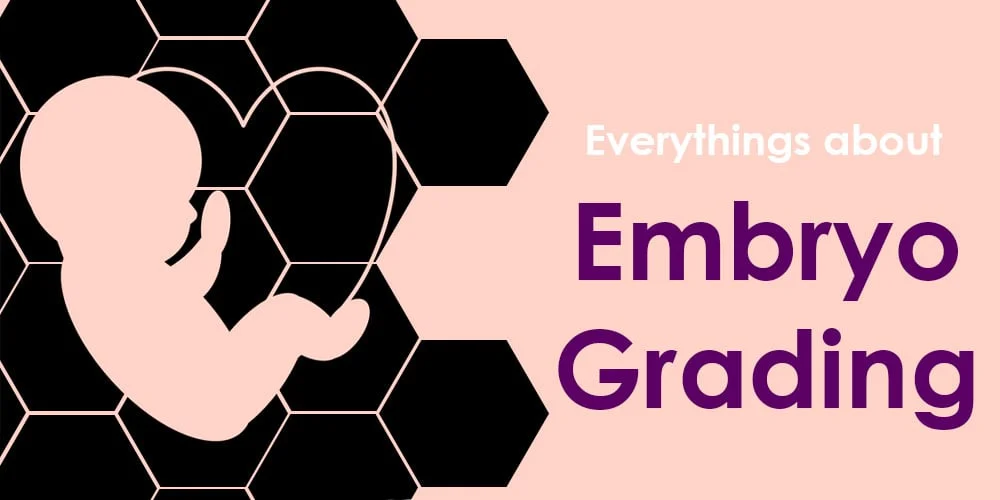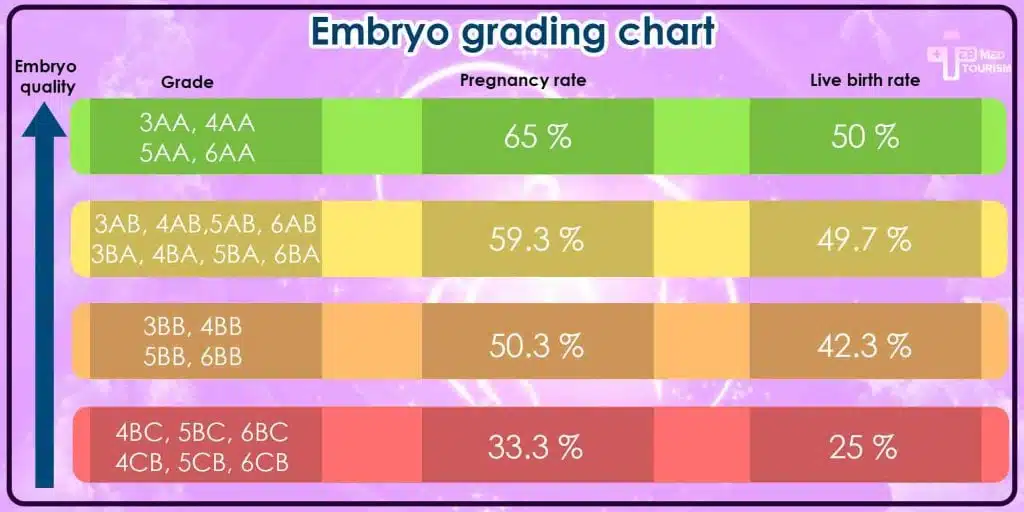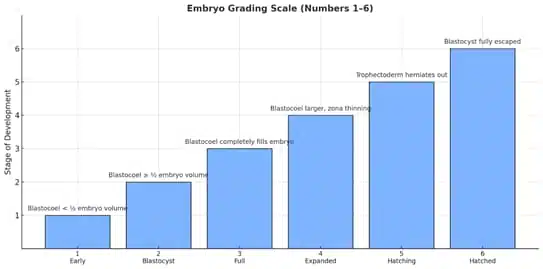In the world of In Vitro Fertilization (IVF), embryo grading plays a pivotal role in determining the chances of a successful pregnancy. As couples and individuals embark on the journey of assisted reproduction, whether they choose IVF in Iran, Europe, or other countries, they often encounter the terms “embryo grading,” “IVF embryo grading,” “embryo grading chart,” “embryo quality chart,” and “embryo grading scale.”
These terms might seem complex at first, but understanding them is crucial for making informed decisions during IVF treatment. In this comprehensive guide, we will delve into the intricacies of embryo grading, the significance of good-quality 5-day embryo blastocysts, and how it all ties into IVF success rates.
What Is Embryo Grading?
Embryo grading is explained as the process of evaluating the quality and developmental stage of embryos created during IVF treatment. This meticulous assessment helps embryologists identify the embryos with the highest potential for a successful pregnancy. To comprehend embryo grading fully, let’s break it down into its key components:
Embryo Grading Chart
Embryo grading is often represented on a chart that categorizes embryos based on their appearance and developmental progress. Sometimes this chart is known as the IVF embryo grading chart.
It (the embryo grading chart) typically includes criteria such as cell number:The number of cells in an embryo at a specific stage.
- Cell Symmetry: The uniformity in the size and shape of the embryo’s cells.
- Fragmentation: The presence of cell fragments, which can impact embryo quality.
- Blastocyst Formation: Whether the embryo has reached the blastocyst stage. Each embryo receives a grade or score based on these factors, with higher scores indicating better quality embryos.
Good Quality 5-Day Embryo Blastocyst
Among the various stages of embryo development, the 5-day blastocyst stage is often considered ideal for implantation. A good-quality 5-day embryo blastocyst is characterized by high cell count, symmetry, minimal fragmentation, and a properly formed inner cell mass. Such embryos are the most promising when transferred, especially in frozen embryo transfer or fresh cycles.
You may also want to learn more about “Fresh vs Frozen Embryo Transfer.”
Embryo Grading Scale
The embryologist will often tell the patient that the blastocyst that has been evaluated consists of a number and two letters, for example, a 5AA embryo: The embryo grading scale, from 1 to 6, measures the degree of embryo expansion of the blastocyst cavity and its progress in hatching out of the zona pellucida.
Embryo Grading Number
The number in embryo grading refers to the stage of blastocyst development—basically, how expanded the embryo is and how close it is to hatching from its protective shell (zona pellucida).
So, the number tells us how far along the embryo is in its development and readiness for implantation.
The letters (A–C) then describe the quality of the inner cell mass (future baby) and trophectoderm (future placenta).
The degree of expansion increases as the embryo expands. Totally, it means the blastocyst development stage or blastocyst grading! Here we ask this question: how does embryo grading work?
- Number 1: Early blastocyst is indicated by the blastocele being less than half the volume of the embryo.
- Number 2: Blastocyst is indicated by the blastocele being greater than or equal to half of the volume of the embryo.
- Number 3: A full blastocyst is indicated by the blastocele completely filling the embryo.
- Number 4: An expanded blastocyst is indicated by the blastocele volume being larger than that of the early embryo and the zona pellucida thinning.
- Number 5: A hatching blastocyst is indicated by the trophectoderm starting to herniate through the zona pellucida.
- Number 6: Finally, a hatched blastocyst is indicated by the blastocyst having completely escaped from the zona pellucida.
The quality of the inner cell mass, which potentially becomes the cells that form the body of the embryo after implantation, is indicated by the first letter on a scale from A to C (A being the highest).
- Grade A: Many cells of ICM (inner cell mass) are tightly packed.
- Grade B: In ICM, several cells are loosely grouped.
- Grade C: ICM has very few cells. The quality of the trophectoderm, the cells that give rise to the placenta and extraembryonic tissues after implantation, is indicated by the second letter on a scale from A to C (A being the highest).
Implantation is the process of the human blastocyst attachment to the luminal epithelium of the uterus within six to eight days after fertilization.
- Grade A: The trophectoderm has many cells forming a tightly knit epithelium.
- Grade B: TE has just a few cells.
- Grade C: Loose epithelium is formed by very few cells of trophectoderm.
The grading system assigns high scores like 4AA or 5AA to embryos that are of high quality, but lower scores do not necessarily mean that the embryo cannot implant and develop into a healthy baby.
It is unclear which degree of expansion is best and whether the ICM or TE is more important in determining embryo quality. Another important factor in grading embryos is the day they reach the blastocyst stage.
To sum up, embryos that reach the blastocyst stage on day 5 are considered to be developing well, while those that take 6 or 7 days may indicate an issue with cell division timing. However, even blastocysts that take longer to develop are still capable of implanting. For instance, as shown in the embryo quality chart, a 4bb embryo has less quality than a 3aa embryo, a 4aa embryo, and a 6aa embryo.
Grading Day 3 Embryos
The day three embryo grading procedure evaluates the quality of embryos at the cleavage stage of development and usually focuses on fragmentation, uniformity, and cell quantity.
Typically, embryos are ranked from 1 to 4 or 5, where 1 represents the best. Even lower-quality embryos can result in healthy pregnancies; thus, while higher-grade embryos are frequently linked to greater pregnancy rates, grade by itself does not ensure success.
Grading Day 5 Embryos (Blastocysts)
Day 5 embryos, also called blastocysts, are categorized according to the quality of their trophectoderm (TE), inner cell mass (ICM), and growth stage. Grades 1 through 6 are assigned to the expansion, with 6 being fully hatched. A is the highest mark, and the ICM and TE receive grades ranging from A to C.
The Impact of Embryo Grade on IVF Success Rates
Embryo grading plays a major role in predicting IVF success rates because higher-graded embryos (like 4AA or 5AA) generally have higher chances of implantation and live birth.
However, grading is not a guarantee because some lower-grade embryos can still develop into healthy babies, and even top-graded embryos can have genetic issues. Grading is ultimately just one component of the entire IVF process; other elements that influence success include patient age, reproductive history, uterine environment, and genetics.
Blastocysts that are well-developed and have healthy internal structures are more likely to result in successful pregnancies. Studies have shown that transfers using excellent-grade blastocysts, such as those with a grade greater than 3AA, have a clinical pregnancy success rate of about 65%.
Blastocysts with an average grade, including 4BB, 4AC, 4CA, 2AB, or 2BA embryos, have a success rate of about 50%. Poor quality blastocysts, such as 3BC, 4CB, 4CC, or 2BB, have a pregnancy rate of just 33%. So, the 3AA, 4AA, 5AA, and 6AA embryo success rate is the highest, about 65%.
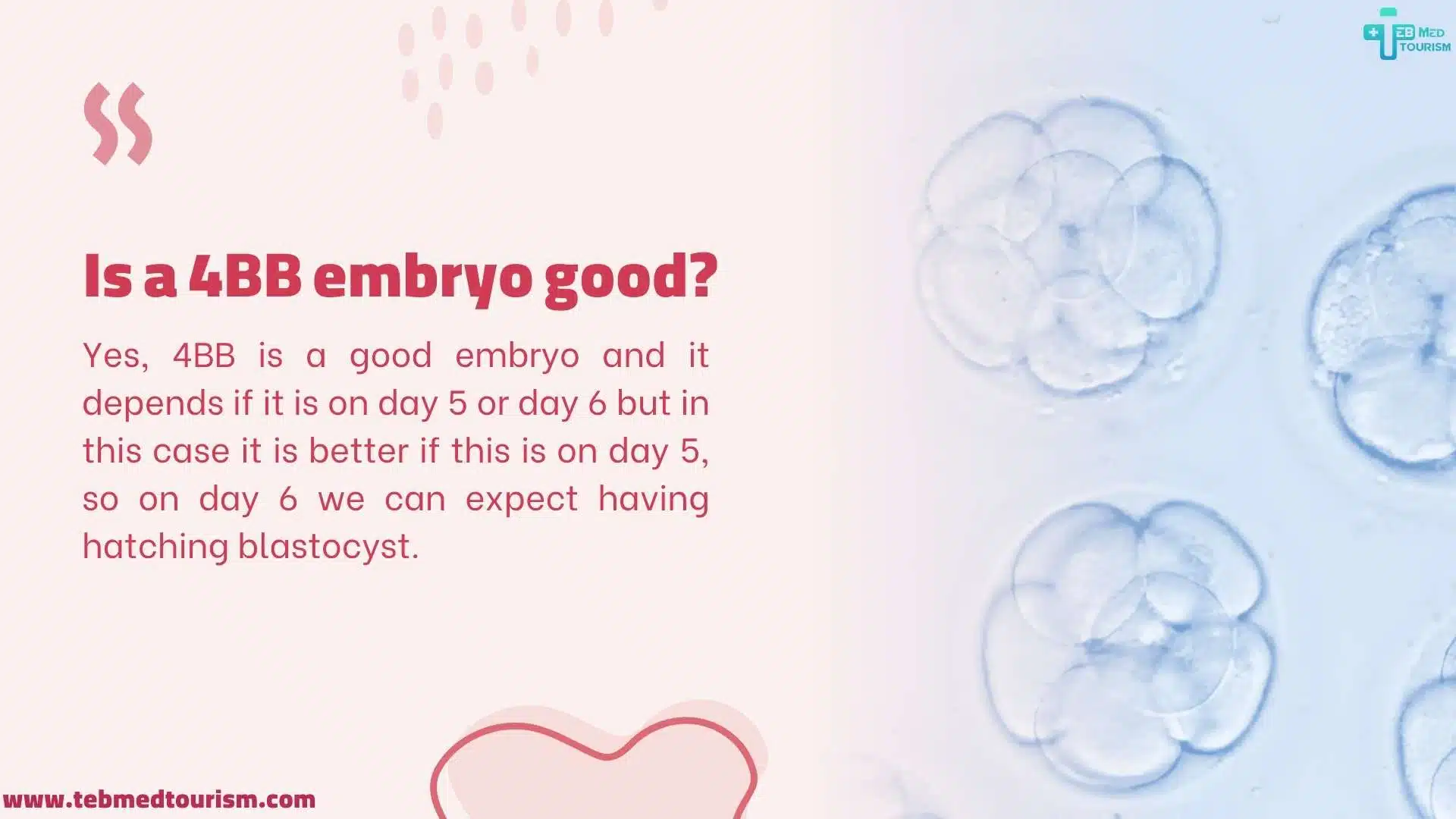
The following chart demonstrates the most desirable blastocyst grades, which are indicated in blue and have the greatest likelihood of resulting in pregnancy. Blastocysts in the orange area would be considered poor, while those in the red areas would not be viable and would likely be discarded.
Nonetheless, this chart provides a useful guide to the relative value of the embryos presented in your Day 5 IVF report (embryo grading chart day 5). One of the wishes of couples is to do IVF with them.
However, it’s important to note that the actual likelihood of pregnancy depends on more than just the quality of your embryos. The preparation of your surrogate and the skill of the embryologist also play a significant role in the ultimate success.
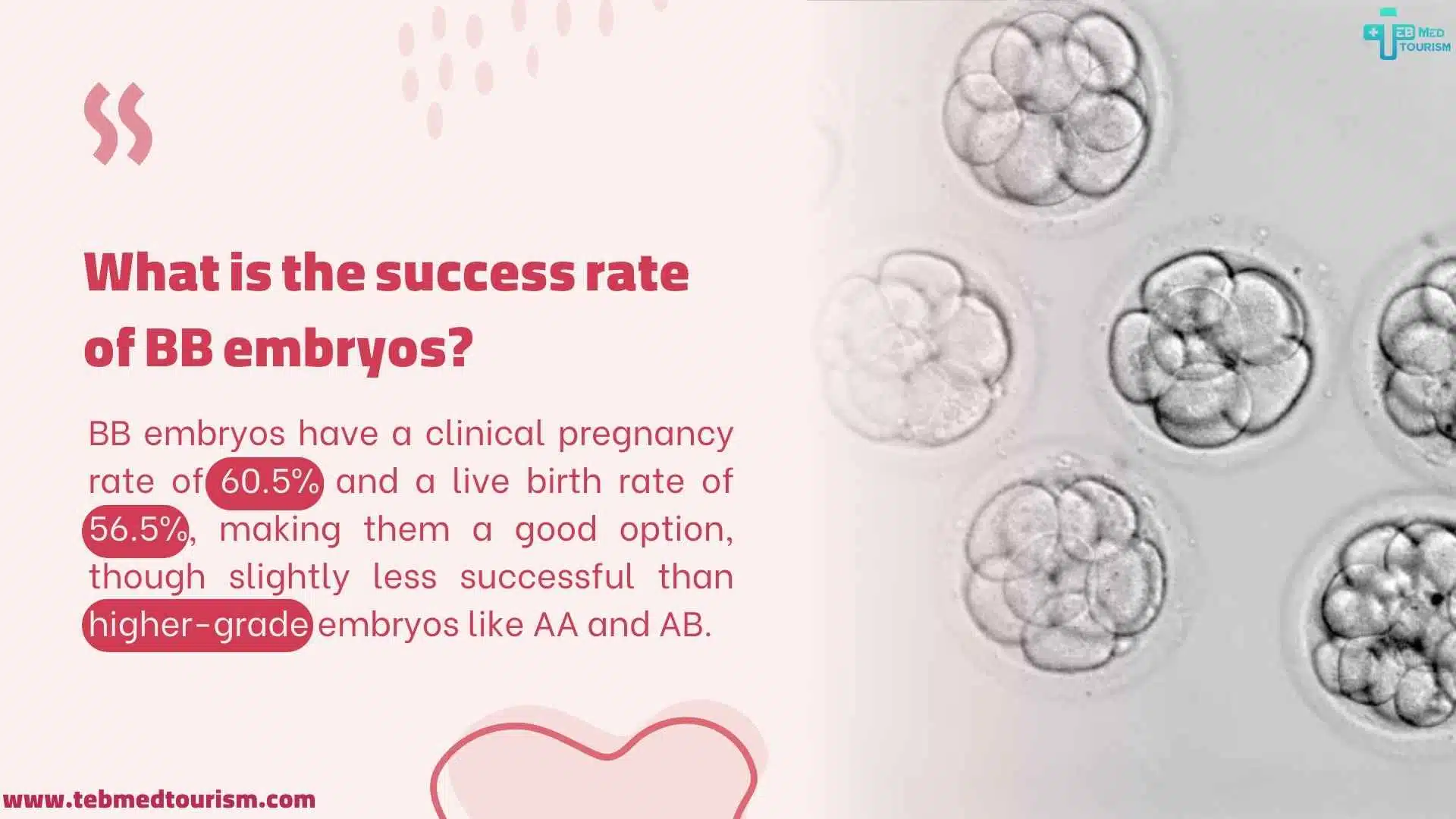
Suitable Grade for Embryo Freezing
For freezing, embryos with an ICM (Inner Cell Mass) grade of A or B and a trophectoderm grade of A, B, or C are often deemed appropriate. It is also preferred for blastocysts to have higher expansion grades, such as expansion levels 3 and above.
Embryo Grade and Gender Selection
Surprisingly, high-quality embryos have a relationship with gender! However, you must remember that gender selection and embryo grading are the two separate phases of the IVF procedure.
Embryo grading is a technique that helps physicians determine which embryos have the best chance of implanting successfully.
During the process, some couples also request gender selection in Iran, where advanced technologies combined with embryo grading allow them to choose the sex of their baby under ethical guidelines. On the other hand, because both sexes appear to be identical under a microscope, grading alone cannot identify a male or female embryo.
Therefore, Preimplantation Genetic Testing (PGT), which looks at the embryo’s chromosomes, is used in clinics to determine gender. Grading helps identify the healthiest embryos, while PGT enables exact gender selection when necessary.
When Do You Decide the Final Embryo Grade?
After the eggs have fertilized, the first stages of embryo grading are usually completed on Days 3 and 5 following egg retrieval. When an embryo reaches the blastocyst stage, which may occur on Days 5, 6, or 7 of culture, the final embryo grade is often obtained.
The grading process involves assessing factors such as cell number, cell symmetry, fragmentation, and blastocyst formation, and assigning a grade or score based on these criteria.
According to a paper that was released in 2011, male embryos were 2.6 times more likely to produce stage 5 or 6 blastocysts than female embryos. Therefore, embryo grading is a crucial aspect of IVF treatment that involves evaluating the quality and developmental stage of embryos to identify those with the highest potential for a successful pregnancy.
In the clinics that work with TebMedTourism, all embryos are selected from the excellent grade, which has made the IVF success rate in this company over 57%, which is higher than the world average and makes us one of the best clinics in the world.
Why Do Embryos Fail with Good Grading?
Even with a high embryo grade, immunological responses, problems with the uterine environment, or genetic anomalies might cause implantation failure.
For this reason, experts advise close observation upon transfer. In order to promote uterine receptivity and lower risks, patients are frequently counseled on foods to avoid following embryo transfer.
Positive symptoms like breast soreness, spotting, or moderate cramping following embryo transfer should also be monitored, as they may be indicators of early implantation but are not always indicative of pregnancy.
Conclusion
Embryo grading significantly influences IVF outcomes, allowing patients to make informed decisions. High-grade blastocysts generally yield the best results, but success depends on uterine health, expertise, and post-transfer care. Identifying post-transfer care details and positive signs after embryo transfer can further enhance success.
TebMedTourism has an IVF success rate of around 57%, which is greater than the global average, because all of its embryos are of good grade. When choosing between fresh and frozen cycles, gender selection, or IVF in Iran, patients can improve their chances of success by being more knowledgeable on embryo grading.
What is a good quality 5-day embryo blastocyst?
A good-quality day-5 blastocyst has many uniform cells, minimal fragmentation, a clear blastocoel cavity, and well-formed inner cell mass and trophectoderm. These embryos have the best chance of implantation.
What is the success rate of grade 3 blastocysts?
Grade 3 blastocysts (e.g., 3AA) are considered good quality, with about a 65% clinical pregnancy success rate. Lower-grade 3 embryos (like 3BC) may drop to around 33%.
What is the success rate of grade BA embryos?
Embryos graded BA (e.g., 2BA or 4BA) fall into the “average” category, with an estimated ~50% success rate.
What is the success rate of embryos by grade?
Excellent-grade (≥3AA, 4AA, 5AA, 6AA): ~65% – Average-grade (e.g., 4BB, 2BA): ~50% – Poor-grade (e.g., 3BC, 4CC): ~33%
Is a 3AA embryo good?
Yes, a 3AA embryo is considered excellent and has a high chance of implantation, around 65% success rate.
Is a 4AA embryo better or a 5AA embryo?
Both are excellent. A 4AA and a 5AA embryo have very similar high success rates (~65%). The number mainly reflects the degree of blastocyst expansion, not necessarily a difference in implantation potential.







